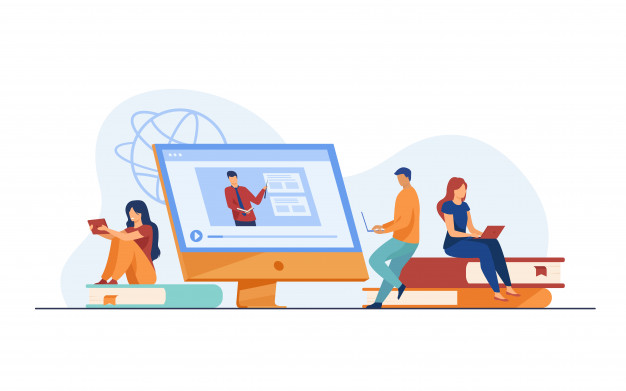
In this era of technology, like other sectors education sector has also adopted emerging trends. Some of the emerging trends in educational technologies are as follow.
Table of Contents
ELEARNING
With the rapid spread of Covid-19 and school closures, distance learning became an educational technology trend. Due to this, the demand for educational online educational platforms increased. eLearning is education or electronically distributed training.
For example, it could be slide-based activities online, or it could be a course online that helps businesses train employees with the skills they need.
Along with eLearning, educational materials are delivered to learners via computers, laptops, tablets, or smartphones. Not only to save time but also to open many doors for interactive learning. They also learn by interacting directly with on-screen information, for example, by dragging content from one place to another. Moreover, the decision-making circumstances in eLearning also encourage learners to make their own choices of what they will learn next.
BLOCKCHAIN TECHNOLOGY
Distributed laser technology from blockchain brings many benefits to DG (DLT) education, especially data storage. Every time new data is added, it adds another “block” to the system, so the storage is technically unlimited. At the same time, the data will be encrypted and distributed to multiple computers in the system. It makes transaction data decentralized and transparent. Although Blockchain technology is used extensively in online courses (MOOCs) and ePortfolios to test skills and knowledge.
ARTIFICIAL INTELLIGENCE (AI)
It is now possible for teachers to automatically do multiple-choice grading and fill in blank questions. Thus, the automatic grading of students’ writing will not lag far behind. Moreover, both learners and teachers can benefit from AI. For example, when teachers are too busy taking care of everyone, students are more likely to use AI. Could get help from tutors. Also, AI-powered programs can provide helpful feedback to both learners and teachers. That’s why some schools use AI systems to monitor student progress and alert teachers when there may be a problem with student performance.
Therefore, it is not far-fetched that AI is a powerful assistant for classroom teaching. In the meantime, why don’t you help your students get the most out of their academic experience through AI?
IMPROVED ACCESSIBILITY THROUGH LEARNING TECHNOLOGY
Computer-based games, applications, and digital learning devices play an important role in the education of students with disabilities. As new technology emerges for both home and classroom, students are more able to learn in a way that meets their needs and is more inclusive, reducing the stigma of assistive technology. For example, Udi audiobooks, assignment help uae, dictation software, and reading applications help many students with disabilities such as visual/auditory challenges or dyslexia already present.
In this day and age, the increased presence of AI devices such as Amazon Echo and Google Home means that students with and without disabilities are more familiar with the concept of speaking with appliances that can facilitate greater understanding and support of students who need to use an assistant.
Technical in the classroom. It also offers teachers the opportunity to plan lessons and assignments included in class-based device-based learning, creating a more inclusive environment for all students.
LEARNING ANALYTICS
The current scene of learning analytics, particularly for advanced education, has extended significantly. It permits teachers to gauge and report understudy learning just through the web. Subsequently, of these, it is workable for them to more readily comprehend and enhance learning. At the point when instructors read experiences from understudies’ learning measures, they can improve their understudies’ information and abilities as needs be. Besides, learning analytics assists instructors with distinguishing squares of understudies who may have scholastic or social difficulties. From that, instructors had the option to foster an approach to help understudies arrive at their maximum capacity.
COLLABORATIVE LEARNING
We connect, discuss and craft situations collaboratively. This collaborative approach has also gained importance in the learning process. For example, in the classroom learning model, teachers encourage collaboration by assigning group activities and tasks.
You will see teachers and students interacting with each other more often. Teachers are now much more accessible and act as mentors to help students in their holistic development. This collaborative learning approach allows students to interact with their peers and build their interpersonal skills.
LEARNING OUTSIDE THE CLASSROOM ENVIRONMENT
Mobile-based devices have taken learning beyond the classroom. With mLearning and eLearning in popularity, students can learn at their own pace and time. This trend is expected to continue as it is a convenient method of teaching as well as delivering. In addition, creating mobile-first responsive content helps students get through their courses anytime and anywhere.
Internet connection is no longer an issue with the ability to read offline. It is complete with notation tools, bookmarks, hyperlinks, dictionaries, and search features, making learning an eBook more flexible. Mostly educational institutions have adopted mobile learning in their learning ecosystems. The benefits are shared by students and teachers alike.
SOCIAL MEDIA IN LEARNING
They can comment on someone’s post or share links to other websites while building peer networks and enhancing the learning online learning experience. Teachers allow social media as part of the learning model as it helps students stay interested in their curriculum and increase engagement.
Social media is here to stay, and incorporating it into learning modules will create a culture of collaboration and sharing, which will lead to a learning improvement experience.
INTERACTIVITY IN THE CLASSROOM
Bringing technology to the classroom has made the classrooms come alive and interactive. With eBooks, course content can be embedded with videos, augmented reality, audio files, and more. Unlike a printed book, an eBook allows for more interaction in the classroom.
The students of the reversed classroom enable students to do all the teaching at home and all the practical work in the school. All of these new technologies have changed the way classes traditionally work. For example, teachers can now help and guide students with homework in class. They can have discussions and classroom activities, creating an interactive environment where students are fully involved.


